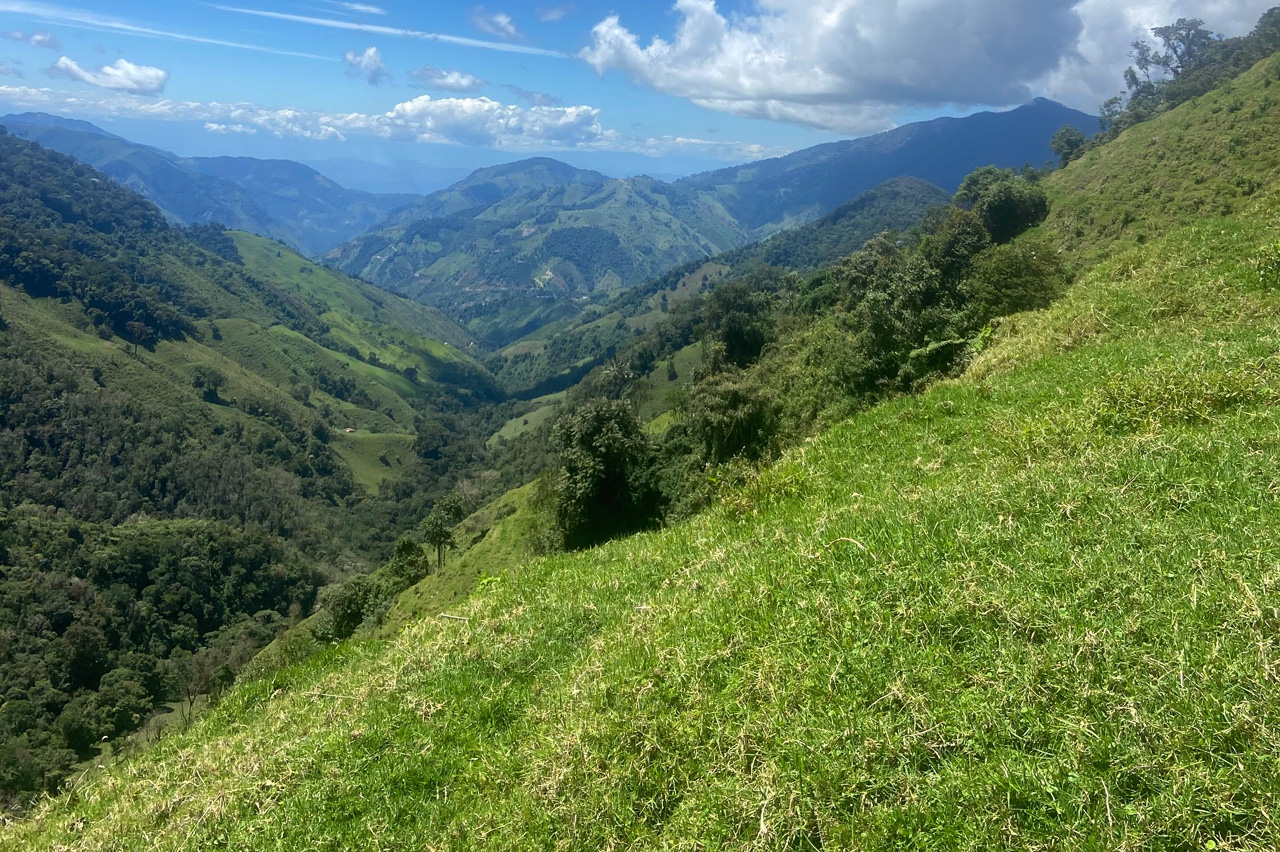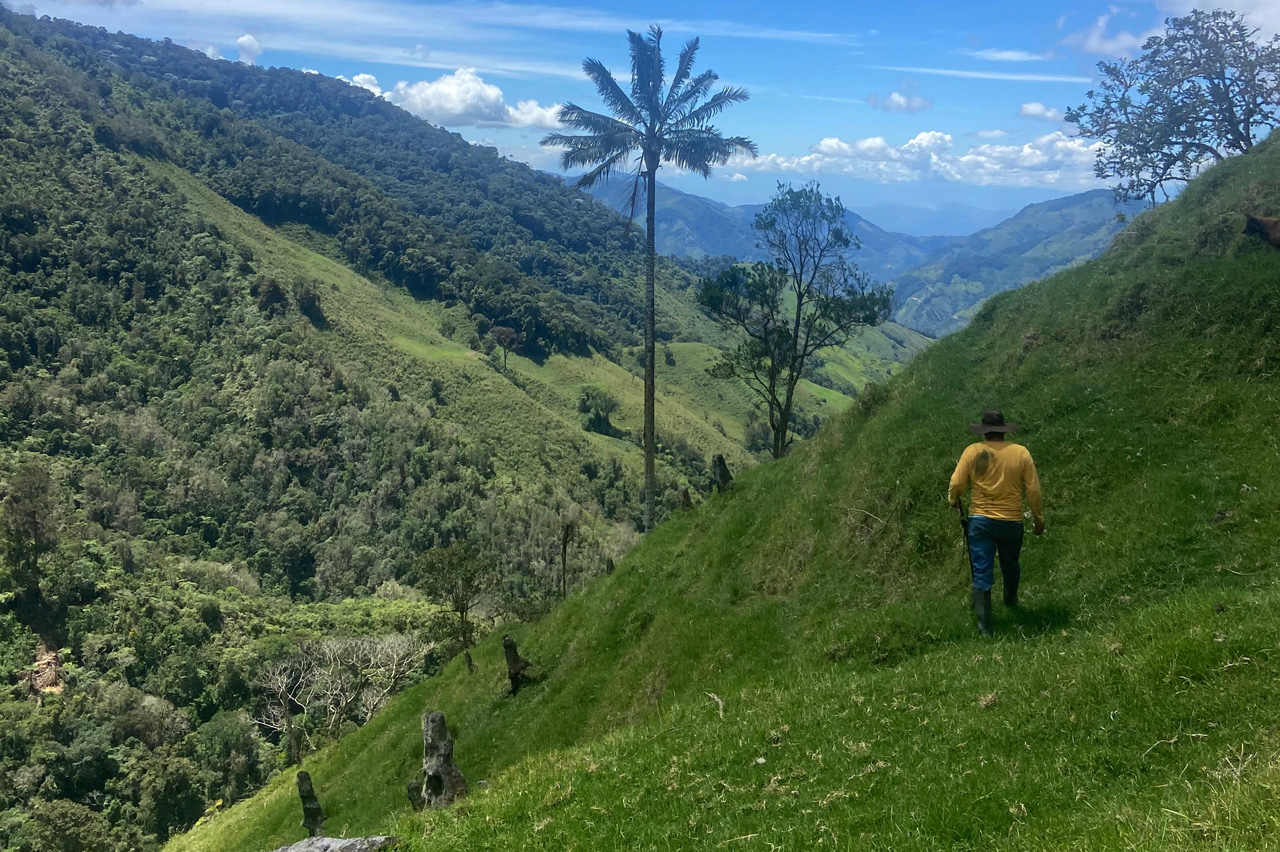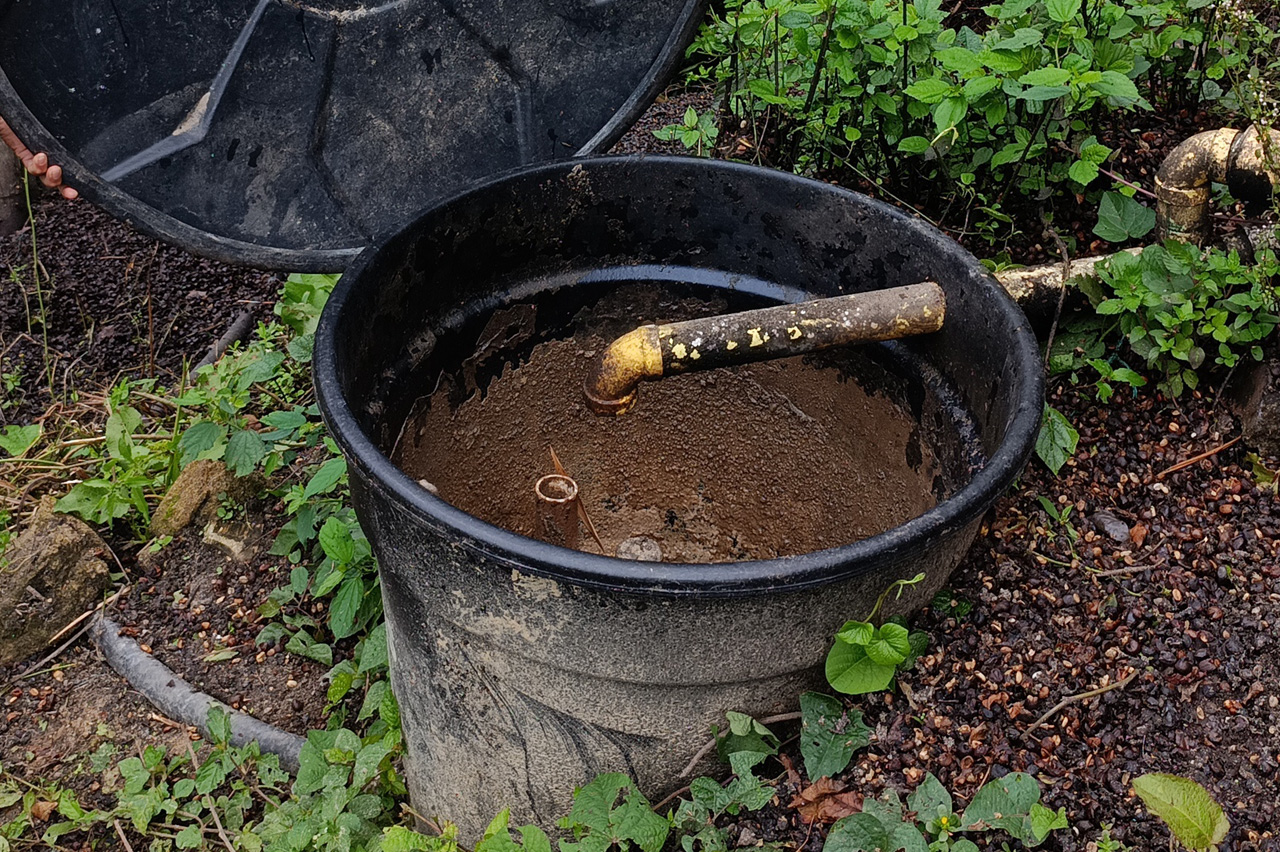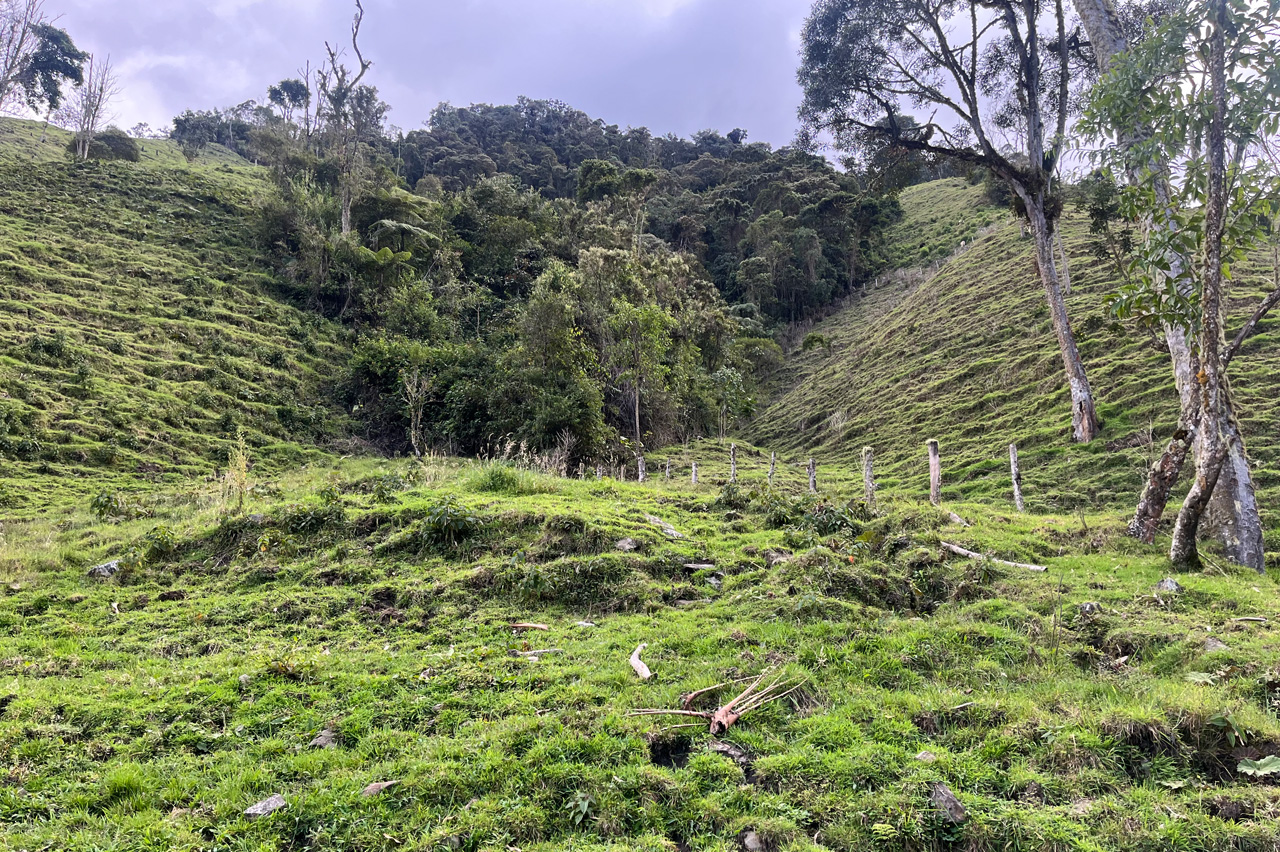By: Jacobo Patiño Giraldo
Diego Londoño owns a cattle farm in the municipality of Roncesvalles, Tolima. There, about 2,600 meters above sea level, he produces milk and meat among pastures, forests, and natural springs. However, over the years, he has noticed that everything around him has changed. “These lands once had excellent vegetation, and the pastures were full of trees, but those have been cut down, and many have died,” he says.
 Photo: William Bravo / WCS Colombia
Photo: William Bravo / WCS Colombia
Deforestation, extensive cattle ranching, and other unsustainable agricultural practices have degraded the natural landscape of this and other municipalities in Tolima, which form part of the upper basin of the Saldaña River—the department’s most important tributary to the Magdalena River.
Concerned about these changes, Diego decided to sign a conservation agreement with the Saldaña River – A Basin of Life alliance*. This is a voluntary pact in which landowners commit to protecting the natural ecosystems on their properties in exchange for various benefits. “We realized we have to help the environment, give back what it has given us. Go plant trees, protect the springs and the water,” he explains.
But what exactly are these agreements? And how do they contribute to conservation? Diego, along with two other landowners who are at different stages of implementation, shared their motivations, commitments, and efforts to turn their farms into spaces where agricultural production and biodiversity can coexist.
The Role of Local Landowners in Conservation
In a country like Colombia, where nearly half of rural land is privately owned, finding ways to engage landowning families in conservation efforts is essential to protect natural resources.
It is within this context that conservation agreements play a key role. “They are good-faith commitments signed between two parties, through which landowners improve their livelihoods while positively impacting the services and biodiversity provided by ecosystems,” explains Fanny González, Conservation Areas Specialist at WCS and coordinator of the alliance.
Conservation agreements are entirely voluntary and can be established between landowners and a variety of stakeholders—public entities, non-governmental organizations (NGOs), private companies, or foundations. This makes them an accessible avenue for protecting strategic natural areas such as forests, ecological corridors, or water sources.
 Photo: William Bravo / WCS Colombia
Photo: William Bravo / WCS Colombia
In the case of Saldaña River – A Basin of Life, the initiative seeks farms whose families are interested in protecting forests and, especially, freshwater systems. “Ultimately, these agreements aim to prevent the expansion of the agricultural frontier and to keep production activities within the existing areas. There can be no logging except for domestic use with proper permits, and no hunting of wildlife. The goal is to preserve the existing forests on the property and avoid any activities that may threaten their conservation,” González explains.
To support this goal, the project provides participants with tools and materials to help protect the natural areas of their farms—such as fencing, posts, and drinking troughs for cattle. “We provide everything needed to fence off natural vegetation and water sources from livestock, while also improving production systems,” she adds.
Additionally, the project offers training and technical assistance to help farms continue producing while adopting more environmentally friendly practices. “For cattle farms, a sustainable ranching specialist visits the property to advise owners on how to improve their production systems and reduce impacts. We also work with coffee farms, focusing on the treatment of both domestic wastewater and the so-called ‘honey waters’ generated during coffee processing, thus reducing contamination that reaches rivers and streams.”
In return, landowners commit to maintaining the fences and systems installed and to continuing the use of sustainable practices in their production.
New Agreements in the Saldaña River Basin
For Diego Londoño, the goal is to fence off the forested areas and natural springs and to restore tree cover. He also dreams of transitioning his cattle production toward a silvopastoral system—a model of livestock management that integrates specific forage plants to feed cattle and help reduce environmental impacts. “They’ve already visited my property and walked through it. We’re excited to start. The materials are arriving soon,” he says.
Meanwhile, Fabio Méndez and Ángela María Celis—also cattle ranchers and fríjol cargamanto (cranberry bean) producers—recently signed a conservation agreement for their farm in the Cañón de Las Hermosas area. “The agreement will last about three years. I’ll receive trees to plant and some materials to divide the paddocks so the cows don’t damage them. We also commit not to cut down the forest and to take care of the environment,” Méndez explains.
 Photo: Lía de la Ossa / WCS Colombia
Photo: Lía de la Ossa / WCS Colombia
Another farm, El Girasol, located in the municipality of Planadas and dedicated to producing coffee, plantain, cassava, and avocado, has already received the necessary materials and is currently meeting its conservation agreement’s goals. “The idea is to keep the forest healthy. We take care not to burn or cut vegetation along the stream banks,” says Teresita Castro, farmer and owner of the property.
Coffee farms like El Girasol must process the beans before selling them. This involves removing the outer pulp and washing off the mucilage—the sticky layer covering the seed. The problem is that the wastewater from this process, known as honey waters, can introduce organic matter that contaminates freshwater sources, leading to algal blooms that deplete oxygen levels and make these ecosystems inhospitable for most aquatic life.
As part of her agreement, Teresita received systems that allow her to properly treat this wastewater. “Now I have a septic tank, a grease trap, and a green filter so the water from coffee processing is treated before being released. We also received very good training. I feel like I learned a lot,” she says.
Can These Agreements Be Sustained?
Conservation agreements are an accessible way to involve local communities in environmental stewardship, but they face a significant challenge: their voluntary nature. “Landowners can withdraw or sell their property at any time. That has happened twice, but we managed to get the new owners to join the program,” notes González.
Ultimately, it’s a matter of good faith. Yet, according to González, the Saldaña River – A Basin of Life alliance provides the necessary tools for long-term continuity. “The idea is to provide all the materials and professional support so that these ‘pacts’ last not just three or five years, but continue into the future, by the families’ own initiative.”
 Photo: Fanny González / WCS Colombia
Photo: Fanny González / WCS Colombia
From the landowners’ perspective, the experience has been very positive. “We’re very grateful; it’s been very beneficial, and I hope it can reach more people,” says Teresita. For Fabio, receiving materials that help protect the forest is both exciting and motivating. “It’s good for our economy because buying all that would be expensive, and besides, everything contributes to protecting the environment.”
Indeed, almost all the agreements signed under the alliance have yielded positive results. According to González, 97% of participants say their farm production has improved, 94% report adopting more environmentally friendly practices, and 100% believe the program has strengthened the conservation of water sources and wildlife.
People who live and work the land understand the importance of conserving it—and they have the will to do so. Opportunities like conservation agreements provide the tools and knowledge that allow landowners to use their land sustainably while protecting the ecosystems that sustain life.
This helps create a much healthier environment where farmers can improve their production systems through environmental sustainability. In Diego Londoño’s words, “This isn’t just for us—it benefits everyone.”
*Saldaña River – A Basin of Life is a public–private alliance between Parques Nacionales Naturales de Colombia, Cortolima, Fundación Grupo Argos, Concretos Argos, and WCS, with the support of Fundación Franklinia and APC Colombia.